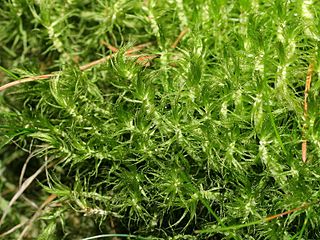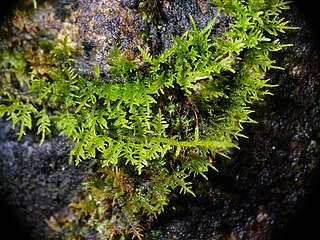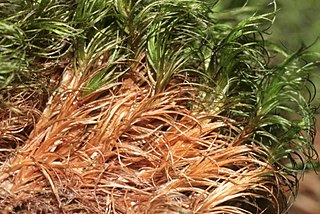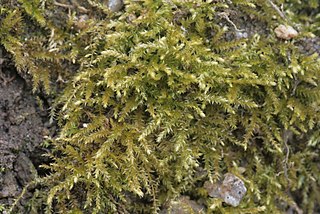
Dicranum is a genus of mosses, also called wind-blown mosses or fork mosses. These mosses form in densely packed clumps. Stems may fork, but do not branch. In general, upright stems will be single but packed together. Dicranum is distributed globally. In North America these are commonly found in Jack pine or Red pine stands.

The Pottiaceae are a family of mosses. They form the most numerous moss family known, containing nearly 1500 species or more than 10% of the 10,000 to 15,000 moss species known.

Barbula is a genus of mosses in the family Pottiaceae.

Ditrichum is a genus of haplolepideous mosses (Dicranidae) in the family Ditrichaceae.

Thuidiaceae is a family of mosses within the order Hypnales. It includes many genera but the classification may need to be refined. The core genera are Thuidium, Thuidiopsis, Pelekium, Aequatoriella, Abietinella, Rauiella, Haplocladium and Actinothuidium form a clade but others currently placed in the family may belong elsewhere.

Campylopus is a genus of 180 species of haplolepideous mosses (Dicranidae) in the family Leucobryaceae. The name comes from the Greek campylos, meaning curved, and pous, meaning foot, referring to the setae which curve downwards.

Thuidium is a genus of moss in the family Thuidiaceae. The name comes from the genus Thuja and the Latin suffix -idium, meaning diminutive. This is due to its resemblance to small cedar trees.

Leucobryum is a genus of haplolepideous mosses (Dicranidae) in the family Leucobryaceae. The name comes from the Greek leukos, meaning white, and bryon, meaning moss.

Homomallium is a genus of moss belonging to the family Hypnaceae.

Plagiothecium is a genus of moss belonging to the family Plagiotheciaceae. It has a cosmopolitan distribution.

Scleropodium is a genus of mosses belonging to the family Brachytheciaceae. The genus has an almost cosmopolitan distribution.

Oxyrrhynchium is a genus of mosses belonging to the family Brachytheciaceae. The genus has a cosmopolitan distribution.
Pylaisia is a genus of mosses belonging to the family Pylaisiaceae.
Platygyrium is a genus of mosses belonging to the family Hypnaceae.

Fontinalaceae is a family of mosses belonging to the order Hypnales.
Platygyriella is a genus of moss in the family Hypnaceae. It was described by Jules Cardot in 1854. It occurs mostly in the Americas, parts of Africa, and parts of Asia.
Platygyriella imbricatifolia is a species of moss belonging to the genus Platygyriella. Before being named Platygyriella imbricatifolia, it was placed in the genus Erythrodontium by R.S. Williams and Jules Cardot. It was then transferred to the genus Platygyriella by Marie Hypolite Irénée Thériot in 1926.
Catagonium is a genus of moss from the family Catagoniaceae. It is found all over the world, especially the Tropical Region.
Catagonium complanatum is a species of moss from the genus Catagonium. It has discovered by Jules Cardot and Viktor Ferdinand Brotherus in 1925. Before the name Catagonium complanatum, it had a basionym named Calliergonella complanata by Cardot & Broth.
Atrichopsis is a genus of mosses belonging to the family Polytrichaceae.













